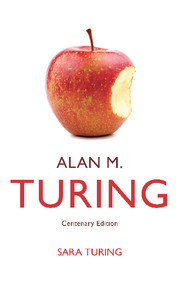Book contents
- Frontmatter
- Contents
- Foreword to the Centenary Edition
- Preface to the First Edition
- Foreword to the First Edition
- Part One Mainly Biographical
- 1 Family Background
- 2 Childhood and Early Boyhood
- 3 At Sherborne School
- 4 At Cambridge
- 5 At the Graduate College, Princeton
- 6 Some Characteristics
- 7 War Work in the Foreign Office
- 8 At the National Physical Laboratory, Teddington
- 9 Work with the Manchester Automatic Digital Machine
- 10 Broadcasts and Intelligent Machinery
- 11 Morphogenesis
- 12 Relaxation
- 13 Last Days and Some Tributes
- Part Two Concerning Computing Machinery and Morphogenesis
- My Brother Alan
- Bibliography
8 - At the National Physical Laboratory, Teddington
Published online by Cambridge University Press: 05 April 2012
- Frontmatter
- Contents
- Foreword to the Centenary Edition
- Preface to the First Edition
- Foreword to the First Edition
- Part One Mainly Biographical
- 1 Family Background
- 2 Childhood and Early Boyhood
- 3 At Sherborne School
- 4 At Cambridge
- 5 At the Graduate College, Princeton
- 6 Some Characteristics
- 7 War Work in the Foreign Office
- 8 At the National Physical Laboratory, Teddington
- 9 Work with the Manchester Automatic Digital Machine
- 10 Broadcasts and Intelligent Machinery
- 11 Morphogenesis
- 12 Relaxation
- 13 Last Days and Some Tributes
- Part Two Concerning Computing Machinery and Morphogenesis
- My Brother Alan
- Bibliography
Summary
On release from his duties at the Foreign Office Alan was offered a Cambridge University lectureship, which he declined since his attention was becoming focussed on computing machinery. Before the war he had already begun to build a computer of his own with wider scope, he hoped, than those then in operation. It was natural, therefore, that his aim should be to see his logical theory of a universal machine, previously set out in his paper “Computable Numbers” (published in 1937), take concrete form in an actual machine. On submission to the Government of the outline of his design for such a machine he was taken on to the staff of the National Physical Laboratory at Teddington, and became a permanent member of the Scientific Civil Service in October, 1945. When this service was reconstructed at the end of the war, senior posts were made available for people of exceptional merit so that “they would be able to advance fairly high in the scientific hierarchy without the usual requirement of undertaking considerable organizational responsibility.” Under this scheme Alan was one of the first to become a Senior Principal Scientific Officer. In the Mathematics Division of the National Physical Laboratory his task was to plan more fully the logical design of an automatic computing engine. According to The Times of 16th June, 1954, “he threw himself into the work with enthusiasm, thoroughly enjoying the alternation of abstract questions of design with practical engineering.”
- Type
- Chapter
- Information
- Alan M. TuringCentenary Edition, pp. 77 - 87Publisher: Cambridge University PressPrint publication year: 2012



